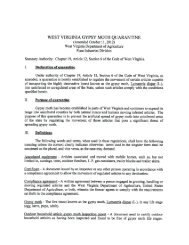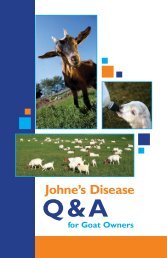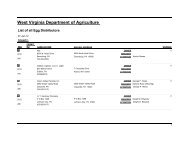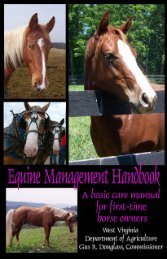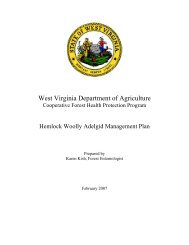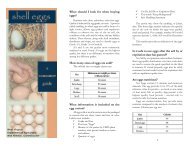Growing Grapes in WV - West Virginia Department of Agriculture
Growing Grapes in WV - West Virginia Department of Agriculture
Growing Grapes in WV - West Virginia Department of Agriculture
Create successful ePaper yourself
Turn your PDF publications into a flip-book with our unique Google optimized e-Paper software.
or medium v<strong>in</strong>eyard is to use awire or cord marked by a knot atthe desired <strong>in</strong>tervals. By simplymov<strong>in</strong>g the ends <strong>of</strong> the l<strong>in</strong>e overthe distance between rows, smallmark<strong>in</strong>g stakes can be driven atthe knots and the v<strong>in</strong>eyard laid outquickly. Some growers prefer tomark <strong>of</strong>f the outside rows with fivetosix-foot uprights, turn furrowslengthwise and across the field,and set the plants at the <strong>in</strong>tersections<strong>of</strong> these furrows. Othersprefer to sight between outsidestakes. Whatever method is used,it is essential that the v<strong>in</strong>es be set<strong>in</strong> sufficiently straight rows so thatthey will not <strong>in</strong>terfere with culturaloperations after the trellis is <strong>in</strong>place. Adequate headland must beleft at each end <strong>of</strong> the site for trellisanchor<strong>in</strong>g and equipment turn<strong>in</strong>g.The rows should run northand south unless there is a goodreason for do<strong>in</strong>g otherwise. Thiswill lead to better light exposure,dry<strong>in</strong>g and disease control. Therows should not run at right anglesto strong prevail<strong>in</strong>g w<strong>in</strong>ds thatmight cause damage by whipp<strong>in</strong>gthe shoots about. The v<strong>in</strong>es shouldfollow the contour <strong>of</strong> a fairly steepsite, or at least run across the hillrather than up and down.At convenient <strong>in</strong>tervals a rowshould be left out to form an alleythat will facilitate harvest<strong>in</strong>gand cultural operations. The alleyshould divide the v<strong>in</strong>eyard <strong>in</strong>toblocks about twice as long as theyare wide. If the field is long, 25-footcross alleys at 1,000 foot <strong>in</strong>tervalsare also desirable to facilitate harvest<strong>in</strong>gand fertiliz<strong>in</strong>g.In <strong>West</strong> Virg<strong>in</strong>ia, grapes should-8-generally be set <strong>in</strong> early spr<strong>in</strong>g toavoid w<strong>in</strong>ter kill <strong>of</strong> fall set plants.Care should be taken to see thatthe plants do not dry out. Whenthe plants are received from thenursery, the bundles should beopened and the roots soaked forseveral hours if they seem dry. Ifthe ground is not prepared andcannot be prepared with<strong>in</strong> a dayor two, the young v<strong>in</strong>es should beheeled <strong>in</strong> or held under refrigerationuntil ready for sett<strong>in</strong>g. Whencarried to the field, they should bekept <strong>in</strong> a pail <strong>of</strong> water or a wet sackand should not be dropped far <strong>in</strong>front <strong>of</strong> the planters. Damaged andexcessively long roots should bepruned back before a v<strong>in</strong>e is set.A crew <strong>of</strong> four persons shouldbe used for sett<strong>in</strong>g grapev<strong>in</strong>es ifpossible - two to dig holes, one tohold the v<strong>in</strong>e and tamp the soil,and one to backfill. The holesshould be wide enough so that theroots can be spread out and deepenough for the v<strong>in</strong>e to stand a littledeeper than it did <strong>in</strong> the nurseryrow. Make sure the graft union isabove ground if grafted plants areused. A little surface soil should beplaced around the roots <strong>in</strong> the bottom<strong>of</strong> the hole, and the soil shouldbe firmed as the hole is filled <strong>in</strong>to ensure good root-soil contact.Fertilizer should not be placed <strong>in</strong>the holes. After plant<strong>in</strong>g and afterdanger <strong>of</strong> frost, the v<strong>in</strong>e shouldbe pruned to one strong, two-budcane.Most grapes are self-fertile andbear well <strong>in</strong> isolated blocks, but afew, for example Brighton, require<strong>in</strong>terplant<strong>in</strong>gs <strong>of</strong> poll<strong>in</strong>izers suchas Concord.





